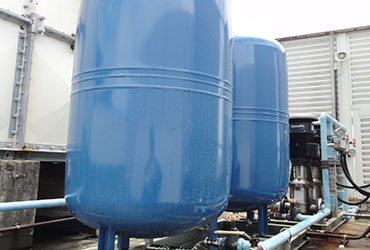Methods to Resolve Low Water Pressure in Your Home
Methods to Resolve Low Water Pressure in Your Home
Blog Article
How do you feel on the subject of 4 Ways to Troubleshoot Low Water Pressure?

Low tide pressure in your house can be a frustrating issue, impacting every little thing from showering to washing meals. If you're experiencing weak water circulation, there are numerous feasible causes and remedies to explore. In this guide, we'll talk about typical reasons for low water stress and useful steps to address the issue properly.
Intro to Low Tide Stress
Low water pressure happens when the flow of water from your taps, showers, and various other fixtures is weak than usual. This can make day-to-day tasks extra difficult and less reliable. Understanding the sources of low water stress is vital to discovering the appropriate remedy.
Common Root Causes Of Low Water Stress
Faulty Stress Regulators
Stress regulators are responsible for maintaining constant water pressure in your house. If they malfunction, it can cause low water stress or unequal flow throughout the house.
Community Water Issues
Sometimes, the trouble exists outside your home. Community supply of water issues, such as main line leakages or upkeep job, can momentarily minimize water stress in your location.
Pipeline Obstructions
Gradually, pipelines can become clogged with mineral deposits, debris, or debris, restricting the flow of water. This is a typical issue in older homes with galvanized steel pipes.
Rust
Rust within pipes can cause leaks and minimized water stress. Rust buildup can constrict water flow, specifically in aging plumbing systems.
How to Identify Low Tide Stress
Inspecting Pipes
Inspect visible pipelines for signs of leaks, deterioration, or clogs. Pay attention to any kind of uncommon noises, such as banging or rattling pipelines, which could show concerns within the plumbing system.
Consulting with a Plumber
If you're unable to pinpoint the cause of low water pressure, consider working with a specialist plumber to carry out an extensive evaluation. They can recognize underlying issues and suggest ideal options.
Inspecting Faucets and Components
Begin by checking the water stress at different taps and components throughout your home. If the problem is separated to certain locations, it may suggest local issues.
Do It Yourself Solutions to Take Care Of Low Water Stress
Flushing Water Heater
Sediment buildup in the water heater can limit flow and lower efficiency. Purging the tank regularly helps eliminate debris and maintain ideal performance.
Inspecting Stress Regulator
Guarantee that the pressure regulator is working properly. Changing or changing the regulator can assist bring back appropriate water pressure throughout your home.
Cleaning Aerators and Showerheads
Mineral deposits can collect in aerators and showerheads, lowering water circulation. Eliminate and clean up these elements routinely to improve water stress.
Clearing Clogs in Pipes
For minor blockages, attempt using a plumbing serpent or chemical drainpipe cleaner to clear blockages in pipelines. Be cautious when utilizing chemicals and comply with safety and security standards.
When to Call an Expert Plumber
If do it yourself efforts fail to solve the problem or if you presume significant plumbing issues, it's best to seek help from a certified plumber. They have the expertise and tools to address complicated problems securely and properly.
Safety Nets to Keep Water Pressure
Installing a Pressure Booster
Consider setting up a pressure booster pump to boost water pressure in locations with constantly low circulation. This can be specifically beneficial for multi-story homes or residential or commercial properties with high-demand components.
Monitoring Water Use
Be mindful of water usage habits and prevent ill-using the plumbing system. Straightforward changes, such as shocking showers and washing lots, can aid maintain adequate water stress.
Regular Upkeep
Set up regular upkeep for your plumbing system to avoid issues such as deterioration, leakages, and clogs. Resolving minor problems early can help prevent more substantial repair services later.
Final thought
Dealing with low tide stress can be frustrating, yet determining the underlying reasons and carrying out suitable solutions can recover optimum flow throughout your home. Whether it's cleaning up aerators, examining pipelines, or seeking advice from a plumber, taking aggressive steps can ensure a steady supply of water for your day-to-day needs.
FOUR WAYS TO FIX LOW WATER PRESSURE NOW
Turning on a shower or faucet only to find the water comes out in a sad, slow drizzle is never a good feeling. How exactly are you supposed to wash a pan or take a quick shower when it takes 10 minutes just to rinse off a little soap? The good news is that when your water pressure is bad, there's always a cause: typically one that can be easily fixed. Here are some of the most common causes of low pressure and what you can do to fix the issue:
DEBRIS AND MINERAL DEPOSIT BUILDUPS
If you notice low water pressure from just one or two of the fixtures in your house, the problem likely has to do with debris buildup. Water is full of minerals and other debris, all of which can accumulate in your pipes and on your fixtures. This can cause a blockage that affects how much water flows through. To fix this, try filling a small plastic bag with white vinegar, and use a rubber band to hang it around your showerhead or faucet. Let the head of the fixture soak for a few hours, and the vinegar should loosen the deposits.
WATER LEAKS
Leaks are another common cause of low water pressure. If water is flowing out of your plumbing through a hole or crack before it can reach your fixture, the pressure coming out of the faucet or showerhead will be lower. A plumbing professional is your best bet for finding and repairing a leak in your water supply pipes.
Leaks are another common cause of low water pressure. If water is flowing out of your plumbing through a hole or crack before it can reach your fixture, the pressure coming out of the faucet or showerhead will be lower. A plumbing professional is your best bet for finding and repairing a leak in your water supply pipes.
A VALVE ISSUE
If you have low water pressure throughout your home, check your main shut-off valve to make sure it's completely open. You may also want to see if there's a pressure-reducing valve installed. If there is, have a plumber help you adjust the settings to get the pressure you're looking for.
OTHERS USING WATER
Believe it or not, your low water pressure could be caused by your neighbors. If you notice low pressure at certain times of day, it may be because you and the people living next to you have similar schedules - when everyone is showering at the same time, the pressure will be lower in every home. Low pressure throughout the neighborhood may also be caused by an issue with your municipal water supply. If that's the case, call the supplier to see if they're working on the issue.
https://www.rotorooter.com/blog/water-leaking/low-water-pressure-fixes/

As an enthusiastic person who reads on Dealing with Low Water Pressure in Your Home, I was thinking sharing that short article was a good idea. Please set aside a second to distribute this blog post if you enjoyed it. I value reading our article about 10 Reasons for Low Water Pressure in Your House.
Click Here Report this page